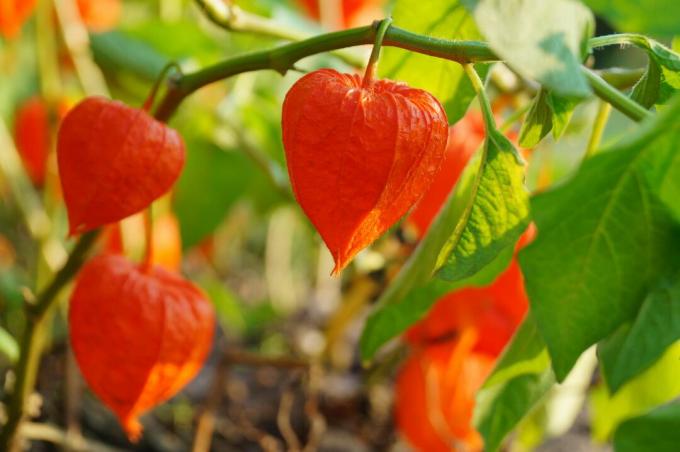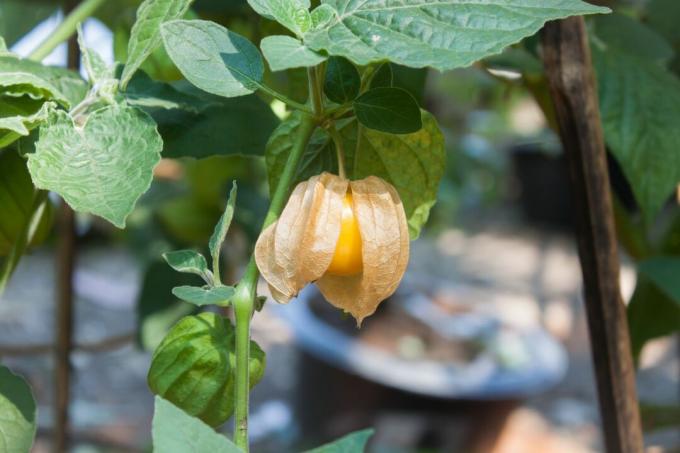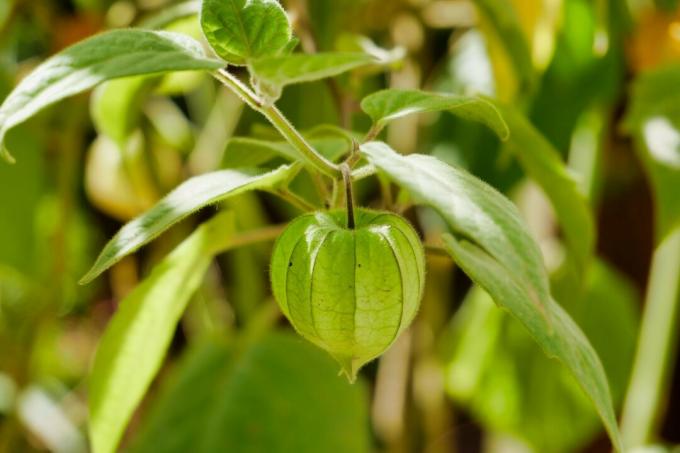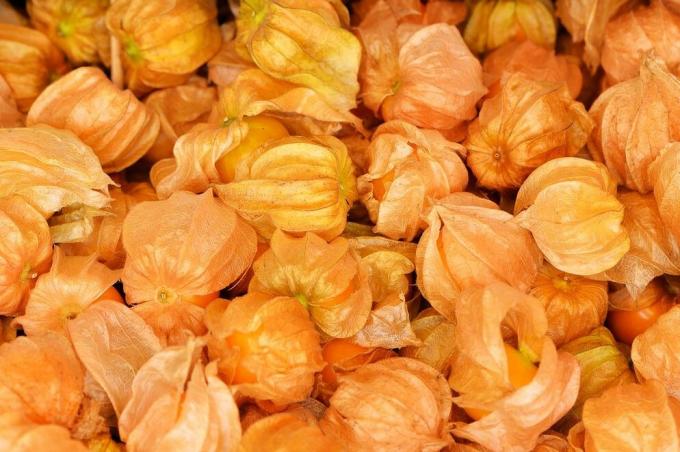The exotic physalis is becoming increasingly popular. Here you can find out everything about the Physalis varieties, the propagation and harvest of the delicious fruits. We also answer which physalis are edible.

The physalis (Physalis sp.) belongs to the nightshade family (Solanaceae) and is close to the tomato (Solanum lycopersicum) related, which it also resembles in terms of care and planting. There are several species in this genus, some of which are edible and some of which are only used as ornamental plants. Our native representative of the genus Physalis is the lantern flower (Physalis alkekengi), whose fruits are only suitable for consumption when fully ripe. In the following article you will learn everything about the history and origin of the physalis, the planting and propagation and of course the correct care of the Andean berries.
contents
- Physalis: origin and characteristics
- Are physalis poisonous?
-
Physalis species and varieties
- Chinese lantern flower (Physalis alkekengi)
- Cape gooseberry (Physalis peruviana)
- Pineapple Cherry (Physalis pruinosa)
- Tomatillo (Physalis ixocarpa)
- Strawberry Tomato (Physalis philadelphica)
- Propagate physalis
-
Harvest, store and use physalis
- Storage of physalis
- Uses and ingredients of Physalis
Physalis: origin and characteristics
The origin of the physalis lies in South America, more precisely in the northern Andean regions of Peru and Bolivia. There it is a perennial, wild and shrubby growing berry plant, the fruits of which are also offered at local markets. It became widespread in other tropical, subtropical and even temperate regions by seafarers. Before 1807 the physalis was brought by the Portuguese to South Africa to the Cape of Good Hope and has been cultivated there ever since. This is where its nickname Cape gooseberry comes from. In South Africa it is also heavily grown commercially and processed into jam or canned. Due to its popularity, it is almost a staple food there. The plant did not reach Europe until the end of the 18th century. Century. The name “Physalis” comes from the Greek and means “bubble”, which is due to the paper covering of the berry fruits.

Physalis plants reach a height of up to two meters, but there are also bushy growing varieties of only about 50 to 80 cm. In our latitudes, the physalis typically blooms from June and delivers its tasty berry fruits from the end of August until the first frost. Cape gooseberries have heart-shaped, fluffy hairy leaves and bell-shaped flowers, which during the fruit formation form a "bubble" over the berry and so in the well-known "Chinese lantern" transform.
The fruit of the physalis is roughly the size of a cherry, strikingly yellow-orange in color and has innumerable small kernels. Because of their shape, the nicknames "bladder cherry" or "Andenkirsche" arose. It tastes sweet and sour and extremely fruity like a mix of pineapple (Pineapple comosus), Kiwi (Actinidia arguta), Passion fruit (Passiflora edulis) and gooseberry (Ribes uva-crispa).
The Physalis is typically cultivated as an annual plant in our latitudes. However, it is actually perennial, which means that you can put the Hibernate physalis can.
Are physalis poisonous?
The bitter green plant parts of all Physalis species are slightly poisonous and can lead to stomach cramps, vomiting and other symptoms of intoxication. Although the ripe fruits of the Physalis are edible - although they are also in some species like the Physalis alkekengi taste barely edible - but caution is advised. Unripe physalis fruits are poisonous because they contain the alkaloid solanine, which causes cramps. These should therefore not be consumed as they can lead to the above-mentioned symptoms of intoxication. But here too there are exceptions: The tomatillos (Physalis ixocarpa) some varieties are also edible when they are not ripe.
Note: The green plant parts of the physalis are also poisonous for pets such as cats and dogs if they eat on them. Fortunately, they rarely show any interest in the plants.
Physalis species and varieties
The genus originally from South America Physalis has a number of species, most of which do not bear fruit that is human. In the following section we would like to introduce you to the most popular varieties and species.
Chinese lantern flower (Physalis alkekengi)
This plant is almost a messenger for autumn, its characteristic lanterns then glow in deep orange to red and resemble a Chinese lantern. The lantern flower is not hardy, but reappears every year thanks to annual self-sowing in suitable locations. The green parts of the plants of this physalis are slightly poisonous. The berries, on the other hand, are edible when fully ripe, but taste slightly bitter and sour-sweet.

Cape gooseberry (Physalis peruviana)
The best-known and at the same time particularly tasty subspecies of this genus is the Cape gooseberry. It is particularly popular as an edible decoration and as a vitamin-rich fruit with a mildly sour aroma, which also thrives in our gardens.
The best Physalis peruviana-Sorts:
- ‘Heitmann’: This variety, bred for early maturity, reaches a height of up to 150 cm. It forms somewhat smaller, but large masses of sweet-fruity berries wrapped in lanterns.
- ‘Inca plum’: The up to 150 cm high plants form many cherry-sized, deep-orange berries. The taste is extremely fruity and sweet with a distinct acidity.
- ‘Lady Madonna’: Juicy-sweet variety with striking elongated skins and quite large orange-yellow berries. This variety grows to about 150 cm high.
- ‘Little Lanterns’: Ideal for growing physalis in pots, hanging baskets or on the balcony. The heavily branched and overhanging plants provide a rich yield of cherry-sized, orange-colored fruits.
- ‘Preciosa’ is a Physalis variety only about 80 cm high. It forms many small golden yellow fruits and ripens as early as mid-August.
- ‘Schönbrunn Gold’: The fruits of this variety are particularly large, dark yellow in color and taste very aromatic with a fine sweet and sour note. The plant can be up to 2 m high.

Pineapple cherry (Physalis pruinosa)
As the name suggests, the sweet taste is reminiscent of the Pineapple cherry that of a ripe pineapple. The plants grow bushy and small, ripen much earlier than the Cape gooseberry and produce an incredible number of small yellow berries. As soon as the fruits are ripe, they fall from the bush by themselves and can then be easily picked up. Hence the nickname earth cherry.
The best pineapple cherries:
- ‘Geltower selection’ was bred for extra large fruits. The aroma of this approximately 50 cm high pineapple cherry turns out to be extremely sweet and pineapple-like.
- ‘Goldie’ comes from the USA and makes large orange berries with a taste reminiscent of pineapple and strawberry.
- ‘Izumii’ reaches a height of only 40 cm and thus finds space on every balcony. The approximately 1 cm large, light yellow berries taste strikingly sweet and fruity and ripen as early as July.
Tomatillo (Physalis ixocarpa)
Tomatillos, also called blue physalis, are mainly known in Central and South America. The fruits are large, purple and light yellow to greenish and have an apple-like, fruity and spicy, but not particularly sweet taste. They are often overcooked into salsa and jams. The tomatillo fruits, which are up to 5 cm in size, also thrive in this country. Some varieties can already be consumed unripe - the taste of green apples is particularly distinctive. At least two plants ensure good pollination of the flowers, which bumblebees also like to visit. The crisp, slightly sticky berries ripen from September as soon as the lantern splits and can be stored for several weeks.
The best tomatillo varieties:
- ‘Amarylla’ forms light yellow, firm and juicy fruits that ripen as early as August. This European variety is particularly good for jams and salsa.
- ‘Mexican Husk’ enchants with light yellow to deep purple fruits, depending on the sunlight. It can also be consumed unripe as a snack between meals. Their taste is very reminiscent of an apple.
- ‘Purple Coban’ comes from Guatemala and is grown there on a large scale. The purple-brownish green fruits taste extremely spicy and sweet.

Strawberry tomato (Physalis philadelphica)
This variety comes from Mexico and is grown there as a vegetable, just as it is in the southern United States. There it is also an integral part of traditional dishes, whereas this type is hardly considered in Europe. ‘Purple de Milpa’ is one of the best-known varieties and forms deep purple, almost black fruits with an aromatic, slightly spicy taste. Allegedly it is one of the best strawberry physalis varieties with a stature height of about 150 cm.
Were you able to choose one of the delicious varieties and types? Now it's time to grow and cultivate the heat-loving Physalis. A detailed guide to the Growing physalis get in this article.

Propagate physalis
The physalis can either be grown in a bright room from February onwards using seeds or directly propagated using cuttings. Sowing takes place from mid-February to mid-March on the bright, warm window sill. Fill the sowing pots with a nutrient-poor soil - like ours Plantura organic herb & seed compost - and put the individual seeds in it. The sowing depth is about 0.5 cm. Now the seeds should always be kept moist and warm at 20 to 25 ° C. Germination takes about 10 to 20 days. As soon as the first true leaf has formed after the two cotyledons, prick out and put into individual pots. The Physalis plants will now grow in the house in a light and warm place until mid-May before they can be planted out.
When wintering Physalis, it makes sense to use the spreading plant at the same time for propagation via cuttings. To do this, after harvesting from October to the beginning of November, cut off about 10 cm long head cuttings with about five to seven leaves. All leaves except for the tip of the shoot are removed so that the cutting does not evaporate too much water over the leaves.
The cuttings are now placed in pots with nutrient-poor soil - like our Plantura Organic herb & sowing soil - set, kept well moist and rooted at around 15 to 20 ° C room temperature. The rooted cuttings are moved to a cooler but light room after about three to four weeks, where they overwinter at a temperature of 10 to 15 ° C. Before you plant the Physalis outdoors, you should wait for the last frost in mid-May.

If you have planted the Physalis in pots or beds from mid-May, summer will soon begin and the first maintenance measures will be due. Everything about the right one Care of physalis you can find out in our special article.
Harvest, store and use physalis
After the lanterns have turned from green to light brown, the time has finally come: the physalis can be harvested. However, you should make sure that the lantern is completely dry. The Physalis ripens relatively quickly; the harvest can take place around seven to ten weeks after flowering. The harvest time of the physalis begins in July and August and when touched, the ripe lanterns almost fall into the hand. Some species, such as the pineapple cherry, simply drop ripe fruits together with the lantern on the ground, where they can then be picked up and then enjoyed.
Tip: Only almost completely ripe Cape gooseberries can be brought to full ripeness in the house, together with the fruits such as bananas and apples that produce the ripening gas ethylene. Unfortunately, green or only half-ripe fruits no longer reach the point of consumption.

Storage of physalis
The ripe fruits can be kept cool and dry with their lanterns in the refrigerator for about one to two weeks. Without a shell, the delicious lantern fruit shrinks or molds quickly. Tomatillos, on the other hand, are more robust and can be stored dry and at room temperature for four to six weeks without any problems. The berry fruits should not be frozen, however, as they will burst and become mushy when thawed. Gently dried physalis can be stored for a few months.
Uses and ingredients of Physalis
Physalis can be consumed fresh when ripe, but they can also be made into jam, jelly or fruity salsa. They are particularly suitable for raw consumption and as a decoration, but are also popular as compotes or jams. If you dip the berries in liquid chocolate, they can be nibbled like pralines.
The ingredients of the Physalis offer a nutrient-rich mix of vitamins and minerals. For example, it is an excellent source of vitamins C, B3 and B12 as well as provitamin A and also provides calcium, iron, manganese and phosphorus. In addition, the healthy Physalis is rich in polyphenols and carotenoids, making it a particularly healthy snack.
In addition to the classics tomatoes, peppers and the like, the nightshade family also includes exciting and exotic fruits such as these Tamarillo. We will introduce you to the tree tomato and give you tips on care and harvest.



